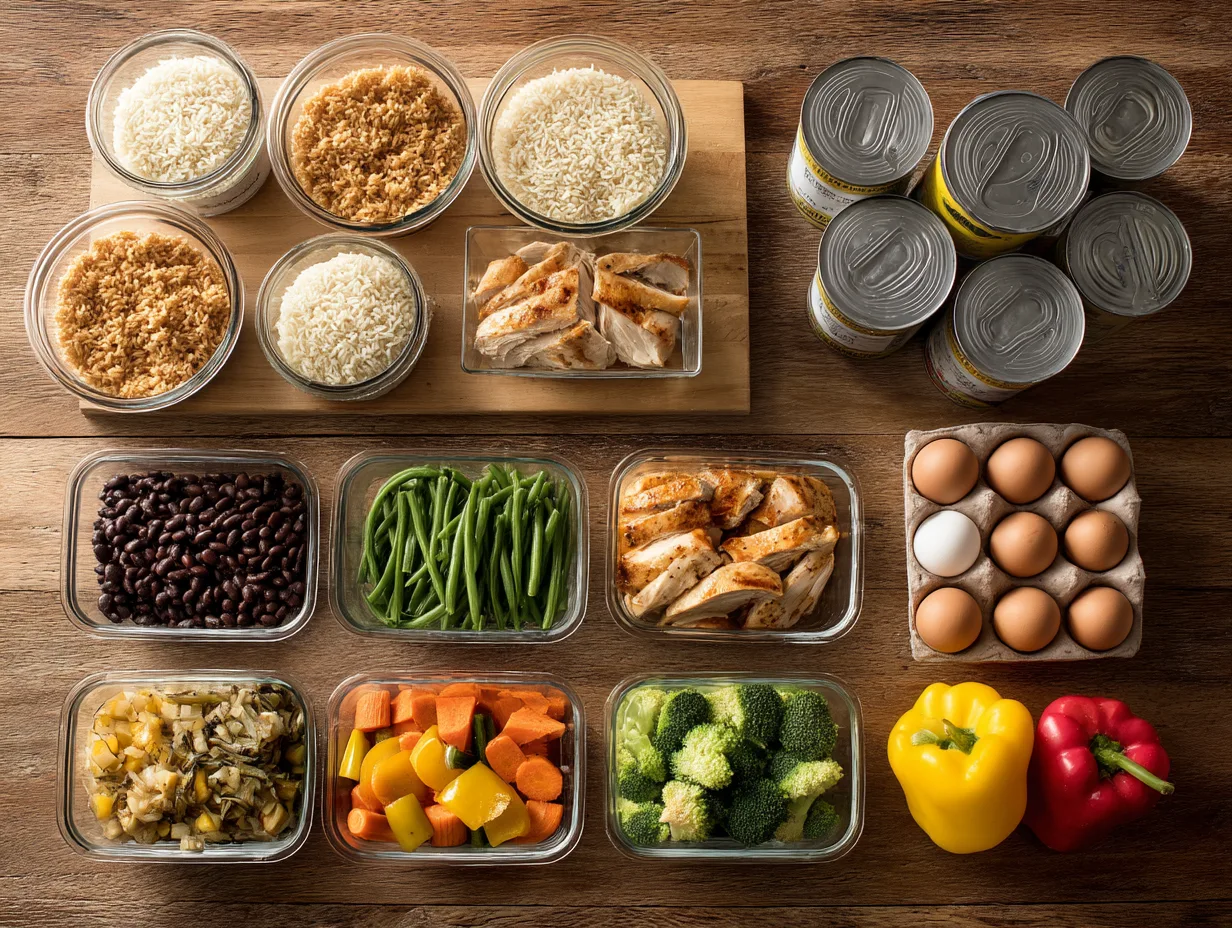Managing diabetes doesn’t have to mean breaking the bank. With strategic shopping, smart cooking techniques, and a bit of creativity, Diabetic Meal Planning on a Budget is entirely achievable. This guide covers cost-conscious approaches to buying groceries, assembling balanced meals, and keeping blood sugar levels in check—all without compromising on flavor or nutrition.
Why Diabetic Meal Planning on a Budget Matters
Balancing blood sugar levels can become more challenging when financial constraints limit your food choices. For those living with diabetes, budget concerns may seem at odds with the need for healthy, nutrient-dense meals. However, there are effective ways to stretch your dollar while maintaining a diabetes-friendly diet.
- Cost Savings and Health Benefits: By focusing on affordable, whole foods and meal prepping in bulk, you can reduce both your grocery bill and your A1C levels.
- Accessibility: Low-income families and individuals often face a higher risk of diabetes-related complications; learning budget-friendly tactics can help mitigate these issues.
- Diet Consistency: Consistent, mindful meal planning reduces reliance on last-minute takeout, which can be both expensive and high in simple carbs.
If you need more guidance on what foods to include in a diabetes-friendly diet, visit our post on Best Vegetables for Diabetes Control. It covers nutrient-packed veggies that are both affordable and blood sugar-friendly.
Setting Goals for Diabetic Meal Planning on a Budget
Before hitting the grocery store, clarify your objectives:
- Stable Blood Sugar: Focus on balanced meals rich in protein, fiber, and healthy fats.
- Nutrient Density: Prioritize foods that offer vitamins, minerals, and antioxidants.
- Cost Efficiency: Opt for staples that can be purchased in bulk and have a longer shelf life.
- Ease of Preparation: Look for meals that are quick to assemble, reducing the temptation for pricier convenience foods.
Budget-Friendly Staples for a Diabetes-Friendly Kitchen
Inexpensive, nutrient-rich foods form the backbone of Diabetic Meal Planning on a Budget. By stocking up on a few versatile staples, you lay the groundwork for an array of recipes.
1. Whole Grains
- Brown Rice or Quinoa: Both are high in fiber and relatively cheap when bought in bulk.
- Oats: A filling breakfast option that stabilizes blood sugar.
- Whole Wheat Pasta: Opt for store brands, which are often less expensive.
2. Beans and Legumes
- Black Beans, Kidney Beans, Lentils: Provide protein and fiber at a fraction of the cost of meat.
- Split Peas: Ideal for soups that yield multiple servings.
- Canned vs. Dried: Dried beans can be more cost-effective, though canned beans offer convenience (just watch for added sodium).
3. Affordable Proteins
- Eggs: Economical, versatile, and low in carbs.
- Chicken Thighs or Drumsticks: Cheaper than chicken breast, but still protein-rich.
- Canned Tuna or Salmon: Shelf-stable options that pack lean protein.
4. Seasonal Vegetables and Fruits
- Frozen Produce: Often cheaper than fresh and just as nutritious. Perfect for soups, stews, or air-fryer snacks.
- Seasonal Buys: Squash, carrots, cabbage, and apples are usually budget-friendly when they’re in season.
- Farmers’ Markets Late in the Day: Farmers might discount leftover produce.
5. Healthy Fats
- Peanut Butter (No Sugar Added): A cost-effective spread providing healthy fats.
- Olive Oil: Buy in bulk for better value. Use it sparingly for dressings or sautéing.
- Sunflower or Pumpkin Seeds: They can be purchased in large bags to reduce cost per serving.
For advice on reading nutrition labels and avoiding hidden sugars, see our post on Decoding Food Labels. Understanding product information can help you stay within budget and meet your dietary goals.
Meal Planning Tactics
1. Weekly Menu Blueprint
Planning a week’s worth of meals at once can help you stick to a grocery list and limit impulse buys. For instance:
- Breakfasts: Oatmeal with cinnamon and chopped nuts, veggie omelets
- Lunches: Bean-based soups, whole wheat sandwiches with lean protein
- Dinners: Chicken stir-fry with brown rice, lentil curry with steamed vegetables
2. Cook in Batches
- Soups and Stews: Prepare a large pot; freeze in portions to save time and reduce waste.
- Grains in Bulk: Cook a big batch of quinoa or brown rice at the start of the week for easy pairing with proteins.
- Leftovers for Lunch: Repurpose dinner remnants as midday meals.
3. Use the Freezer Wisely
- Frozen Vegetables: Quick to cook, usually cheaper than fresh, and always on hand.
- Meat in Bulk: Larger family packs can be divided into smaller portions.
- Leftover Proteins: Turn leftover chicken or fish into salads, wraps, or air-fried delights.
If you’re looking for more ideas on balancing macronutrients in simple dishes, refer to our article on Carb Counting Made Simple. Its tips on portion control and carbohydrate distribution also apply to budget-friendly meal plans.
Diabetes-Friendly, Low-Cost Recipe Ideas
Here are sample meals illustrating how Diabetic Meal Planning on a Budget can be delicious, healthy, and wallet-friendly.
Air-Fried Vegetable Medley
- Ingredients: Frozen broccoli florets, carrots, and cauliflower; a drizzle of olive oil; your favorite spices
- Cost-Saving Tips: Frozen veggies are typically cheaper than fresh, and they won’t spoil quickly.
- Blood Sugar Benefits: High fiber, minimal simple carbs.
- Air Fryer Twist: Crisp up the vegetables with minimal oil. For more air-fryer inspiration, see the Diabetic Air Fryer Cookbook.
Lentil and Veggie Soup
- Ingredients: Dried lentils, onions, carrots, celery, low-sodium broth
- Budget Benefits: Lentils are inexpensive and expand when cooked.
- Blood Sugar Benefits: Rich in protein and fiber to stabilize glucose.
- Large Batch: Make enough to freeze extras for quick lunches.
Chicken Stir-Fry Over Brown Rice
- Ingredients: Chicken thighs, mixed vegetables, low-sodium soy sauce
- Cost-Saving Tips: Choose store-brand rice and affordable veggies like cabbage or carrots.
- Blood Sugar Benefits: Balance protein with fiber-rich vegetables and whole grains.
- Portion Control: Keep your rice serving to about one-quarter of the plate.
For additional low-cost meal ideas, check our post on Low-Glycemic Snacks That Actually Taste Good. Some snack suggestions can double as quick lunch add-ons.
Snacks and Desserts on a Dime
Budget constraints don’t mean you have to skip snacks or desserts. Here’s how to keep them diabetes-friendly:
- Peanut Butter and Celery Sticks: Crunchy, filling, and affordable.
- Air-Fried Apple Slices: Slice an apple, sprinkle with cinnamon, and air-fry for a sweet, low-sugar treat.
- Yogurt Parfait: Layer low-fat Greek yogurt with frozen berries and a sprinkle of oats.
Shopping Strategies for Diabetic Meal Planning on a Budget
- Buy in Bulk: Staples like rice, beans, and oats are cheaper per unit when purchased in larger quantities.
- Compare Unit Prices: Check shelf tags for the price per ounce or pound.
- Opt for Store Brands: Often comparable in quality to name brands but more affordable.
- Seasonal and Local: In-season produce is fresher, tastier, and cheaper.
- Loyalty Programs and Coupons: Take advantage of store promotions and digital coupons to cut costs.
Additionally, plan your shopping trips around sale cycles. Many stores rotate discounts on certain produce or proteins every few weeks.
Meal Prep for Success
Incorporating meal prep can reduce the daily hassle of cooking and lower the temptation to order takeout:
- Weekend Prep: Dedicate a few hours on the weekend to chop vegetables, cook grains, and portion out meals.
- Label and Organize: Store containers in the fridge or freezer with clear labels to avoid confusion and food waste.
- Create a Rotation: Vary recipes each week to keep your menu interesting and nutritious.
If you need additional inspiration on mindful eating habits, our article on Eating Mindfully After Bariatric Surgery offers tips like eating slowly and savoring each bite, which are also beneficial for blood sugar control.
Balancing Blood Sugar on a Budget: A Sample Day
Try this budget-focused menu that sticks to the core principles of Diabetic Meal Planning on a Budget:
- Breakfast (Est. $1.50): Oatmeal with cinnamon and a spoonful of peanut butter; black coffee or unsweetened tea.
- Lunch (Est. $2.00): Lentil soup (batch-cooked), a small side salad, and a whole-grain roll.
- Afternoon Snack (Est. $1.00): Apple slices with a dab of low-sugar peanut butter.
- Dinner (Est. $3.00): Air-fried chicken thighs, roasted carrots, and brown rice.
Each meal prioritizes fiber, protein, and low-GI carbs while remaining wallet-friendly.
Essential Lifestyle Tips
- Regular Blood Sugar Monitoring: Tracking your glucose can help you fine-tune portion sizes and food choices.
- Stay Active: Even low-impact exercises like walking or light aerobics can boost insulin sensitivity.
- Hydration: Drinking enough water supports metabolic processes and may reduce sugar cravings.
- Stress Management: Chronic stress can spike cortisol, affecting blood sugar control.
Where to Find Extra Support
Diabetic meal planning can be simpler with the right network of resources:
- Online Communities: Social media groups and forums where people share budget-friendly recipes and tips.
- Community Programs: Some local organizations offer cooking classes tailored to diabetic needs and tight budgets.
- Professional Guidance: A registered dietitian can customize meal plans that meet both your blood sugar targets and financial limitations.
For more comprehensive guidelines on long-term diabetes management, visit the American Diabetes Association. Their resources cover everything from nutrition basics to exercise routines and mental wellness.
Concluding Thoughts: Diabetic Meal Planning on a Budget
Striking a balance between managing blood sugar and keeping food expenses in check is not only doable but can also be rewarding. By prioritizing low-cost, nutrient-dense staples like beans, frozen vegetables, and whole grains, you can craft a meal plan that supports your health objectives without straining your wallet. Cooking methods such as air frying or slow cooking further minimize costs and calories, ensuring each meal is both economical and diabetes-friendly.
Stay consistent by prepping in advance, exploring store deals, and varying your menu options. In doing so, you’ll create sustainable habits that accommodate both your financial and nutritional needs. With thoughtful planning and a dash of resourcefulness, Diabetic Meal Planning on a Budget can become an integral part of your strategy for controlling blood sugar—one budget-friendly meal at a time.


Leave a Reply